In 2006 I rendezvoused in Kraków with my Australian friends Ben and Claire who live in London; Ben was actually flying in from Paris while Claire arrived from London, so it was about as cosmopolitan as you can get. Last year Narrelle and I were in Budapest when we met up with our friend Celia, who flew in from Germany.
Last weekend saw the latest instalment: Ben and Claire flew out from London to meet me for a weekend in Poznań, Poland. Though it doesn't attract the international tourism spotlight that the likes of Kraków, Warsaw and Gdańsk receive, it's a lively city with a great dining and nightlife scene, courtesy of its big populations of resident students and visiting businessmen.
However, we had a plan for the Saturday which involved getting out into the Polish countryside. We caught an osobowy train (which stops at every stop, no matter how minor) to the western town of Świebodzin (pronounced shvee-e-bo-jeen). It's a fairly quiet and unexceptional locale, except for its newest attraction, the 33 metre high statue of Christ the King, which stands on a modest hill south of the railway line.
Two of the great things about walking in Poland are a) it's flat almost everywhere except the southern borders; and b) Poles don't assume that everyone's going to drive, so even rural attractions are served by decent footpaths. And so it was in Świebodzin. With the help of both Google Maps and eyesight, we navigated along the streets on foot, happening first upon this church:
I was interested in the large hoop-like arrangement below the statue - it looks like a clock, but it certainly wasn't showing the right time. A small mystery along the way.
By this stage we could see the Christ the King statue poking among the trees and houses, but it was unclear the best way to walk there. Then Claire spotted an access road up to the hill, with a pedestrian path alongside, so we headed up.
This is what we found:
It's hard to give a sense of scale here, but 33m is pretty high. In fact arguably it's the tallest of the various big statues of Christ around the world, depending on the stance you take about including/excluding crowns, plinths, hills and various other factors.
Not that the erection of this Jesus was without controversy. It was the brainchild of a local priest, and a lot of residents and Poles across the nation regarded it as a gaudy folly. There has also been some question of whether its foundations are sufficiently strong.
In fact, on the day we visited the hill was fenced off, and an engineering device was at work probably strengthening the structure, as you can see in the photo above. You certainly wouldn't want to be hanging about beneath if Jesus ever fell.
Anyway, we took a few photos and I popped into the gift shop to buy a postcard and stamps, so I could post Narrelle a greeting from JC.
Then we crossed the railway again to Świebodzin's compact Old Town, centred on its Rynek (market square). Here we discovered this unnamed gentleman, presumably a local musical success:
(I later discovered via Google that it's a likeness of Czesław Niemen, famed Polish musician of the 1960s and '70s. What his connection is with Świebodzin, I'm not sure.)
Świebodzin's centre is like an architectural puzzle - as we walked around, we encountered a medieval church, a 20th century church, baroque and art nouveau facades, remnants of medieval walls, and unmistakable communist-era concrete structures.
They were interwoven into the town's layout, no one element dominating, and it made for a fascinating patchwork of styles. It was as if every era in the eventful history of western Poland (which was sometimes eastern Germany) was represented in stone or concrete somewhere in the town.
I paricularly liked the tower of the town hall. Its castle-like turret made it look medieval, but I felt strongly it must be a nostalgic folly of later years - I'd seen this sort of thing before, eg the 19th century mock castle that is Wrocław Główny train station. And sure enough, the clock tower turned out to have been a 19th century addition. Nice, isn't it?
After that, we dropped into a local restaurant featuring chunky old radios as decor, where the menu promised pierogi domowe (home-made dumplings). They were good, too - good enough for Big Jesus.


















